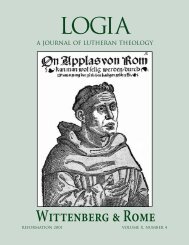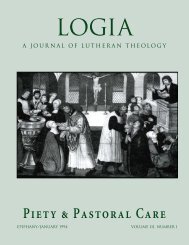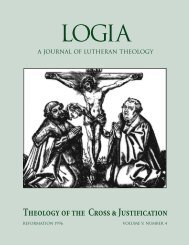52 LOGIAthis, he turned his attention toward writing a great history ofdogma, a project halted by his death on November 21, 1954. Outof his knowledge of the early church he published his Abendmahlund Kirchengemeinschaft in der alten Kirche, hauptsächtlich desOstens in 1954 (translated by Norman Nagel). After his death, DerAusgang der altkirchlichen Christologie was published in 1957,edited by Wilhelm Maurer and Elisabeth Bergsträßer.The Law of GodElert rejected the threefold use of the law taught in seventeenth-centuryLutheranism, namely, civil, theological, and moral.Luther had taught that the principle use of the law was to uncoversin and disclose the wrath of God against the sinner (usus proprius,theologicus seu paedagogicus); a secondary use of the law for Lutherwas to keep mankind outwardly under control (“äußerlich imZaum”), a civil or political use. Like Luther, Elert recognized onlythe theological use, which condemns sin, and the political use,which protects law and public order. Elert spoke of these threefunctions of the law: the creational aspect (Seinsgefüge), the legislativeaspect (Sollgefüge), and the judgmental aspect (Qualitätsgefüge).The first deals with our lives as governed by the conditionsunder which we were created (see Schicksal below). The second orlegislative deals mainly with the Decalogue, with commandmentsand prohibitions. The third is the judicatory function, the law as itexamines the “quality” of our lives and condemns our sins.The noncommittal individual tries to maintain a middleposition toward God and his law, das Mittelpunktsdasein, in whichhe himself instead of God is the measure of all things (p. 89), fromwhich position he confronts and questions the law (die fragendeHaltung) and tries to avoid its demands by a state of detachment(p. 94). The futility of seeking to maintain a middle position overagainst the law is emphasized by the orders of creation as Seinsgefüge,that is, as factors in one’s life that come from one’s havingbeen created and that place a person within certain orders and situationsthat he must accept and over which he has no control. Theperson in the middle is also subject to the legislative character ofthe law (Sollgefüge) as expressed in the Decalogue; God’s lawmakes certain demands of a person’s behavior whether he likes itor not. And the law further challenges the middle position, (Mittelpunktsdasein)when it examines one’s moral quality and exposeshis sin (Qualitätsgefüge).An important concept in the thought of Elert is Schicksal. Itshould be said immediately that this does not mean blind fate.Schicksal comes from the verb schicken, meaning “to send,” andrefers to conditions that have been sent or given us. These are mattersover which one has no control, such as one’s gender, family,stature, physical appearance, natural abilities, race, and otherinherited factors. Elert developed these “givens,” orders, and situationsvery thoroughly in his book Christian Ethos.The natural orders (Seinsgefüge) played an important role inElert’s ethics; these were chiefly marriage and the family, politicalauthority, and spiritual authority. Karl Barth and some of his followers,who rejected a theology of creation or any natural knowledgeof God, unjustifiably castigated Elert’s doctrine of naturalorders. In an excursus on Dietrich Bonhoeffer, Eyjólfsson pointsout that Bonhoeffer developed a position that was very close toElert’s in his “doctrine of mandates” (pp. 73–74). Bonhoeffer recognizedfour divinely commanded mandates: vocation, marriage,government, and church, and added the changeable orders of folk,race, class, masses, society, nation, fatherland, Reich, and others.Important parallels from Paul Althaus and Emil Brunner couldalso be added.The GospelElert listed two important aspects of the gospel: it is a reportabout salvation through Jesus Christ (demonstrative), and it is aproclamation to the individual (adhortative). Hence the gospelnot only imparts information, but it also establishes a new relationshipbetween the individual and God (p. 144–146). “Out ofthe demonstrative, ‘God was in Christ and reconciled the worldunto himself,’ comes the adhortative, in which the readers arecalled to apply this report unto themselves” (p. 148). Elert criticizeddialectical theology for its one-sided emphasis upon theotherliness of God; thereby an infinite distance was placedbetween the word of revelation and the preached word. Thisoveremphasized the gospel as adhortative and neglected the historyof Jesus Christ as demonstrative. Such a separation of reportand promise harms the gospel (p. 145).Elert held that the principle of biblical interpretation is lawand gospel (p. 151). Historical-critical methodology cannot openthe true meaning of the Scriptures because it remains under thelaw. In a manner reminiscent of Martin Kähler, Elert distinguishedGeschichte as higher criticism (law) and Historie as thewitness of the apostles (gospel). Not the law but the gospel, whichis accessible only to faith, provides the key to the Scriptures (p.152). In his dogmatics, his ethics, and his work on history ofdogma, Elert distinguished the portrait of Christ (Christusbild) ofthe four gospels from the dogma of Christ (Christusdogma)found in other parts of the Scriptures, as well as in the dogma ofthe ancient church. The biblical portrait of Christ (Christusbild)is the norm for evaluating the doctrine of Christ (Christusdogma).The portrait of Christ is the “demonstrative” of thegospel, showing what God has done for us in Christ; through thework of the Holy Ghost it becomes the “adhortative,” whichaddresses the faith of the believer. The portrait of Christ, which isparticularly strong in the passion history, should always predominatein theology and in preaching. In the incarnation God’s Sonbecame integrated into our time and space dimension; in the resurrectionthe limitations of time and space were removed, and henow lives beyond these dimensions. “The question of how thepast can become the present, of how ‘Christ is present to us, canonly imply that he, who left our time and space, enters it anew’;and he actually does this in the Holy Ghost” (p. 153).Elert held to a theologia crucis. Unlike some modern theologianswho emphasize Easter at the expense of Good Friday, he laidgreat importance upon the message of the cross and the atonement.Like Luther, he insisted that “Jesus as a man who had placedhimself under the law actually took on our flesh and with it the law,wrath, and curse of God, the devil, and hell; thus the curse that hebore was our curse, and the death that he died was our death.”Contrary to Karl Barth and Carl Heinz Ratschow, Elert insistedupon the sinlessness of Jesus. Christ’s sinlessness marked his positionwith respect to the law: first, he intensified the demands of thelaw, and second, he claimed the right to judge. And this, Christ’s
REVIEWS 53freedom in regard to the law, gives him the authority to forgive sinand to set men free from the demands of the law. In this powerover the law, Jesus makes himself equal to God and claims that he isthe Son of God. These claims of Jesus were acknowledged by Godwhen he raised him from the dead.The death of Jesus was for his disciples the end of theirfaith in him as the Son of God. It was first the resurrectionas God’s action that overcame the ‘crisis’ of theirfaith. Through the resurrection the disciples recognizedthat God himself was at work in that which was done toJesus Christ, and that God let it be done. The destiny ofJesus first became recognizable through the resurrection.In it, God confirmed the claim of Jesus that he was God’sSon (p. 158).Elert acknowledged the importance of Anselm’s contributionto the doctrine of the atonement:It was the merit of Anselm that he placed the criticalimportance of the death of Christ in the center of thedoctrine of the atonement. ‘His basic thought is that thehonor of God, injured by rebellious people, demandedsatisfaction, and that satisfaction was provided in thedeath of the God-Man.’ The doctrine of the atonementwas described by Anselm with the help of legal termswhich, Elert held, were adequate for presenting the NewTestament doctrine of God as judge, and the related judicatureof the law, as well as the nature of justification as ajudgmental act (p. 165).Elert was critical of the doctrine of the threefold office ofChrist under concepts taken from the Old Testament: Christ as“prophet, priest, and king.” He showed that this construction wentback to the Arian church historian Eusebius, that it was introducedby Calvin, and that it was first handled as a discrete doctrine inLutheran dogmatics by Johann Gerhard in the seventeenth century.Elert offered the following criticisms of this doctrine: First,these Old Testament concepts do not do justice to the multiplicityof Christological attributes in the New Testament, but they lead toan unacceptable reductionism, since they have no place for suchterms as “Savior” or “Redeemer.” Second, this reductionism leadsto the attempt to understand Jesus Christ in Old Testament terms.The New Testament should be understood from Christ rather thanfrom the Old Testament, and the Old Testament must be interpretedin the light of the New Testament instead (p. 162).Eyjólfsson summarizes the meaning of the law in theatonement:The comprehensive meaning of the Christ-event isrevealed in Jesus’ relation to the law. What is decisive forus is that Jesus took on the law in its totality, embracingevery earthly relationship as creational, legislative, andjudgmental (als Seins-, Soll-und Qualitätsgefüge). Onlyin taking on the law could his destiny receive a cosmicor universal significance, because the law has preciselythis significance.And he cites Elert’s dogmatics (p. 341): “The death of Christaccording to this is not a simple ending but rather the true completionof his life” (p. 167).Elert emphasized the use of legal or forensic terms in the NewTestament teaching on justification (p. 186). Even if a person couldfulfill the law, God would remain the subject and not the object ofjustification. Elert showed that in Luther’s day, “justification” didnot mean that a sin was overlooked, but that a sin was judged andpunished (pp. 187–189). In his forensic view, Luther avoided trivializingjustification by moralizing or else by excusing the sinner (p.189). In that sense, Elert rejected the position of Karl Holl and builtupon Anselm’s doctrine of the atonement (pp. 189–190).Elert rejected the Young Luther’s concept of faith as a salutarydesperation: “Faith can find nothing in itself, nor can it deriveGod’s judgment as liberation from itself” (p. 193). In his typicalpithy style, Elert writes:God does not cast a person into the misery of guiltinessin order to destroy every thought of merit and to let hisown grace appear as a pure gift. God does not need themisery of people in order to be gracious. In such anevent, the guiltiness of a person and his despair anddeep humiliation toward God’s judgment would be thepresupposition for grace. In both cases, the grace ofGod would no longer be conceived as his free action(pp. 193–194).Elert wrote that the adhortative or direct address ofthe gospel calls the individual to make the decision offaith. Faith is a decision that the individual cannot makewithout the Holy Spirit, but it is important that the individualreally make a commitment. In his attempt to provideindividual responsibility while avoiding synergism,Elert spoke of the person under two separate contexts: the[unconverted] person who is still “in the middle” and hasonly das empirische Ich, an earthly and non-spiritual ego,and das transzendentale Ich, the totally emptied ego thatremains as a receiving ego within the regenerate or spiritualperson. The transcendental ego, which is solely thework of God, is the consciousness of the person who hasfaith; therefore, faith is the work of God in the individual.Only the transcendental ego, which has been effected byGod himself, has the power to make the decision of faith(pp. 180–181).The later Elert was not completely satisfied with the mannerin which he had balanced faith as decision and faith as the work ofGod in his earlier works. Therefore, in his later dogmatics hereplaced the word Entscheidung (“decision”) with the word Betroffenwerden(“having been met by”): faith means that I know thatGod means me with the word of forgiveness and reconciliation.The answer to Betroffenwerden is faith, which is the ratification ofthe adhortative (p. 183).The transcendental ego is the recipient of justification. Justificationitself is fully anchored in the cross of Christ.An atoning significance can be ascribed only to thedeath of Christ on the cross. Before God, Christ bore
















